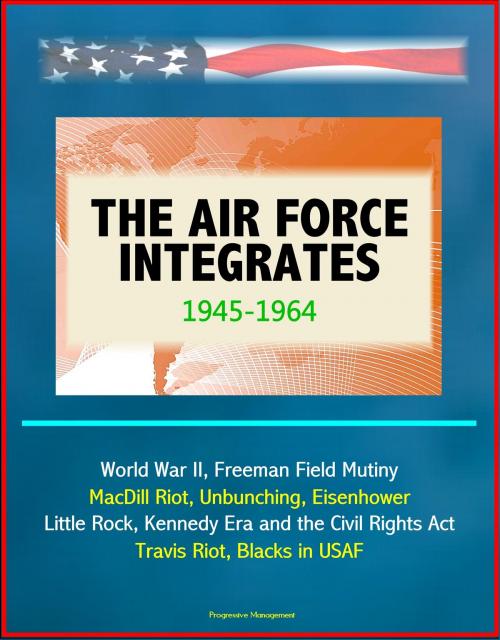The Air Force Integrates: 1945-1964 - World War II, Freeman Field Mutiny, MacDill Riot, Unbunching, Eisenhower, Little Rock, Kennedy Era and the Civil Rights Act, Travis Riot, Blacks in USAF
Nonfiction, History, Military, Aviation, Social & Cultural Studies, Political Science| Author: | Progressive Management | ISBN: | 9781310301322 |
| Publisher: | Progressive Management | Publication: | June 13, 2015 |
| Imprint: | Smashwords Edition | Language: | English |
| Author: | Progressive Management |
| ISBN: | 9781310301322 |
| Publisher: | Progressive Management |
| Publication: | June 13, 2015 |
| Imprint: | Smashwords Edition |
| Language: | English |
Professionally converted for accurate flowing-text e-book format reproduction, this unique USAF publication describes the struggle to desegregate the post-World War II U.S. Army Air Forces and its successor, the U.S. Air Force, and the remarkable advances made during the next two decades to end racial segregation and move towards equality of treatment of Negro airmen. The author, Lt. Col. Alan L. Gropman, a former Instructor of History at the U.S. Air Force Academy, received his doctorate degree from Tufts University. His dissertation served as the basis for this volume. In it, the author describes the fight to end segregation within the Air Force following President Harry S. Truman's issuance of an executive order directing the integration of the armed forces. Despite resistance to this order, fueled by heated segregationist opposition, integration moved ahead somewhat slowly under the administration of President Dwight D. Eisenhower. Progress increased during the administration of President John F. Kennedy, which saw major advances toward achieving equality for Negro servicemen. Colonel Gropman's study is a detailed, comprehensive, and, in many respects, a documentary account. The crucial events it describes more than justify the unusually extended treatment they receive. The volume thus provides a permanent record of this turbulent period in race relations and constitutes a significant contribution to the history of the Air Force.
CHAPTER I - FLYING ON CLIPPED WINGS * Interwar Negro Personnel Policy * World War II Personnel Policy * The Tuskegee Airmen * The 477th Bombardment Group (M) (Colored) * The Freeman Field Mutiny * The McCloy Committee Recommendations * CHAPTER II - MARKING TIME * The Army Studies the Postwar Role of Negro Troops * The First Air Force Report * The Gillem Board Recommendations * Race Violence * The MacDill Riot * Air Force Blacks in the Postwar Period * Ben Davis' Air Force * CHAPTER III - "UNBUNCHING" * The Air Force Shifts Policy * Political Pressure and the Election of 1948 * Air Force Integration * Changing Military Attitudes * CHAPTER IV - BENIGN NEGLECT * The Korean War * Eisenhower and Civil Rights * Little Rock Air Force Base * Air Force Off-Base Discrimination * The Problem in the North * CHAPTER V - THE KENNEDY ERA * The Gesell Committee * Reaction to the Gesell Report * Air Force Opposition * Air Force Equal Opportunity Efforts * Passage of the Civil Rights Act * The Air Force Marks Time * EPILOGUE * Positive Programs Between 1964 and 1971 * The Travis Riot
In April 1945 more than 100 Negro officers forcefully protested segregated facilities and discriminatory policies at Freeman Field, Ind. They were arrested by their white commanders to deny them the opportunity to lead what their superiors termed a mutiny. This significant but little known event*, which occurred in the closing year of World War II, is important in the history of the Army Air Forces because no other event better illustrates the attitude of its white military leadership towards blacks. To understand the factors which precipitated the revolt, it is essential to review Army racial policies formulated during the 1920's and 1930's. These policies, based upon racist premises, affected black and white relations for decades that followed. It should be stressed, however, that the military leadership between the two world wars was no more bigoted than other segments of American society. But that knowledge brought little comfort to those who had to endure the system. Without admitting that it had succumbed to racist theories, the military leadership had in fact adopted the racist hyperbole popular in the interwar years.
Professionally converted for accurate flowing-text e-book format reproduction, this unique USAF publication describes the struggle to desegregate the post-World War II U.S. Army Air Forces and its successor, the U.S. Air Force, and the remarkable advances made during the next two decades to end racial segregation and move towards equality of treatment of Negro airmen. The author, Lt. Col. Alan L. Gropman, a former Instructor of History at the U.S. Air Force Academy, received his doctorate degree from Tufts University. His dissertation served as the basis for this volume. In it, the author describes the fight to end segregation within the Air Force following President Harry S. Truman's issuance of an executive order directing the integration of the armed forces. Despite resistance to this order, fueled by heated segregationist opposition, integration moved ahead somewhat slowly under the administration of President Dwight D. Eisenhower. Progress increased during the administration of President John F. Kennedy, which saw major advances toward achieving equality for Negro servicemen. Colonel Gropman's study is a detailed, comprehensive, and, in many respects, a documentary account. The crucial events it describes more than justify the unusually extended treatment they receive. The volume thus provides a permanent record of this turbulent period in race relations and constitutes a significant contribution to the history of the Air Force.
CHAPTER I - FLYING ON CLIPPED WINGS * Interwar Negro Personnel Policy * World War II Personnel Policy * The Tuskegee Airmen * The 477th Bombardment Group (M) (Colored) * The Freeman Field Mutiny * The McCloy Committee Recommendations * CHAPTER II - MARKING TIME * The Army Studies the Postwar Role of Negro Troops * The First Air Force Report * The Gillem Board Recommendations * Race Violence * The MacDill Riot * Air Force Blacks in the Postwar Period * Ben Davis' Air Force * CHAPTER III - "UNBUNCHING" * The Air Force Shifts Policy * Political Pressure and the Election of 1948 * Air Force Integration * Changing Military Attitudes * CHAPTER IV - BENIGN NEGLECT * The Korean War * Eisenhower and Civil Rights * Little Rock Air Force Base * Air Force Off-Base Discrimination * The Problem in the North * CHAPTER V - THE KENNEDY ERA * The Gesell Committee * Reaction to the Gesell Report * Air Force Opposition * Air Force Equal Opportunity Efforts * Passage of the Civil Rights Act * The Air Force Marks Time * EPILOGUE * Positive Programs Between 1964 and 1971 * The Travis Riot
In April 1945 more than 100 Negro officers forcefully protested segregated facilities and discriminatory policies at Freeman Field, Ind. They were arrested by their white commanders to deny them the opportunity to lead what their superiors termed a mutiny. This significant but little known event*, which occurred in the closing year of World War II, is important in the history of the Army Air Forces because no other event better illustrates the attitude of its white military leadership towards blacks. To understand the factors which precipitated the revolt, it is essential to review Army racial policies formulated during the 1920's and 1930's. These policies, based upon racist premises, affected black and white relations for decades that followed. It should be stressed, however, that the military leadership between the two world wars was no more bigoted than other segments of American society. But that knowledge brought little comfort to those who had to endure the system. Without admitting that it had succumbed to racist theories, the military leadership had in fact adopted the racist hyperbole popular in the interwar years.















